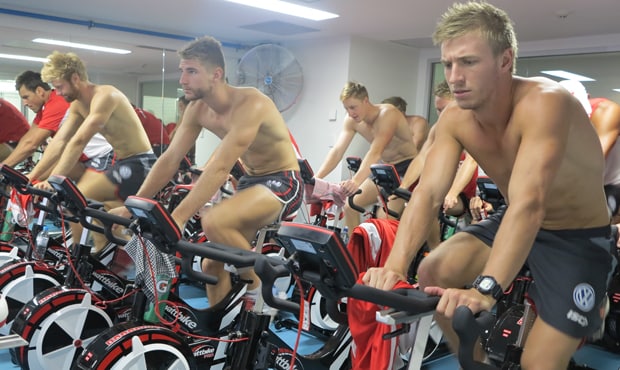Located in the depths of the Swans’ headquarters at the SCG, the state-of-the-art facility, put in place by Altitude Training Systems, provides players with the opportunity to train in altitude environments without stepping outside the club.
At least two times per week throughout this year’s pre-season, Swans players have sweated it out and pushed their bodies to the limit in the high-altitude program, which is overseen by conditioning coach, Matt Pine.
While altitude training camps have been incorporated into the schedules of many AFL clubs in recent times, Pine said the club’s in-house facility allows players to train in environments which mirror the experience of high-altitude training in locations such as Arizona, Colorado or even base camp on Mt Everest.
“It’s basically a room where we can change the percentage of oxygen in there and obviously that has an effect on how hard an exercise session is,” Pine told SwansTV.
“It’s really simulating an altitude environment and by doing that, we get more fitness bang for our exercising buck if you want to put it that way.
“The guys today are at 14 per cent oxygen and normally at sea level we’re at about 21 per cent oxygen, so that simulates about 3500 metres of altitude, so that’s a pretty good effect.
“Obviously the benefit of those camps is that the players are there at altitude for a long block of time, so you get a much bigger physical or physiological effect from that.
“We’re doing short, sharp hits at probably a higher altitude to where those teams travel to and the benefit for us is that we can do it throughout the pre-season and not just in a three-week block, and we can do it throughout the year as well.”

The Swans’ altitude room, which was funded by the Swans Foundation and major benefactor, Basil Sellers, works by reducing the amount of oxygen in the room, which makes it harder for the heart and lungs to deliver oxygen, and for the muscles to take oxygen out of the bloodstream
Simply put, the lower the percentage of oxygen available in the room, the more challenging training becomes for the players.
“The players definitely feel it at 14 per cent (oxygen) and below,” Pine said.
“We’ve been down to 12.5 per cent, and that’s pretty hard work and is getting up to 5000 metres of altitude.
“They definitely sense that shortness of breath and the legs fatigue quicker, so it’s definitely having an effect.
“As to how the guys respond, some guys absolutely love it and love the fact that they’re getting more fitness from that one session and then some other guys don’t like that sensation so much.”
The Swans have also benefitted from the inclusion of 22 new Watt Bikes, which were also funded by Sellers and the Swans Foundation.
The bikes, which have been developed by British Cycling, not only act as a fitness tool but also provide valuable feedback for the playing group and conditioning staff.
“They are a fantastic bike in terms of the way we can set them up like a road bike, but the monitors are the real benefit about them though,” Pine said.
“The guys can get all sorts of feedback on their monitors from what their left leg is doing to what their right leg is doing, their power outputs and their distances .
“The really good thing is that we can project the data which they’re doing in real time up onto the screen and that makes them accountable not only to the staff, but to themselves and to the other players.
“During a session we can set a target for them at a certain interval, and they have to be above that power output and if they’re not, all the other players in the room can see that, so it’s really good motivation tool.”
While the direct benefits of the new facility are hard to measure, Pine said he believed altitude training may have played a role in some of the improvements seen in players this pre-season.
“The benefits are really hard to measure and are hard to separate from all the other effects of pre-season, but we were pretty happy with the time-trial results later in the pre-season,” he said.
“In both the three-kilometre time-trial and the yo-yo test, at least half the runners set PBs in those two tests, so that was a pretty good result for us.
“You’d like to think that the effect of what the altitude sessions have done has played some part in that.”


